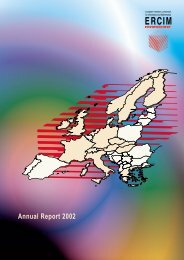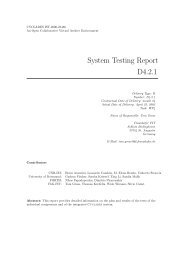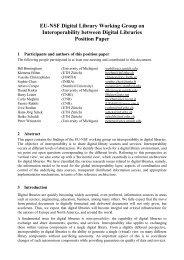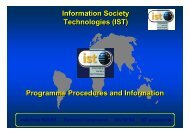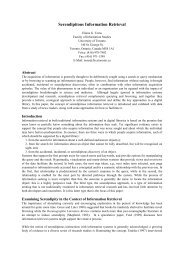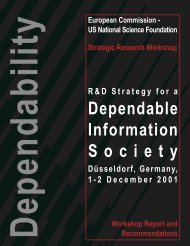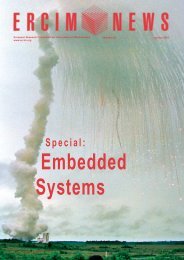Towards a Platform for Widespread Embedded Intelligence - ERCIM
Towards a Platform for Widespread Embedded Intelligence - ERCIM
Towards a Platform for Widespread Embedded Intelligence - ERCIM
You also want an ePaper? Increase the reach of your titles
YUMPU automatically turns print PDFs into web optimized ePapers that Google loves.
60<br />
R&D AND TECHNOLOGY TRANSFER<br />
Satellite Communication Services<br />
SAFE: Satellites <strong>for</strong> Epidemiology<br />
and Health Early Warning<br />
by Catherine Chronaki and Laurent Braak<br />
The risk of epidemics and emerging or re-emerging diseases such as avian flu<br />
or chikungunya fever is rising. Luckily, these risks can be contained with<br />
prevention, early warning, and prompt management. In this context, current early<br />
warning and response systems, although well-developed in Europe, could benefit<br />
from satellite services.<br />
Detection and monitoring of potential<br />
risks has become an important part of the<br />
so-called 'Epidemic <strong>Intelligence</strong>' as a<br />
reaction of surveillance systems to the<br />
risk of epidemics arriving from lessdeveloped<br />
areas outside Europe. Health<br />
early warning systems in areas remote,<br />
inaccessible, or prone to natural or manmade<br />
disasters enabled by satellite communications<br />
can significantly limit the<br />
risk of onset and the effects of epidemics<br />
and contribute to settling major public<br />
health issues. Economically speaking,<br />
satellite communications can also save<br />
money by enabling rapid and coordinated<br />
response and optimal adjustments<br />
of resources when deploying an emergency<br />
plan.<br />
The SAFE project, co-funded by the<br />
European Space Agency (ESA), will<br />
develop and demonstrate the added<br />
value of satellite communication services,<br />
including low and high bandwidth<br />
access to Internet, co-operative working<br />
and geolocalisation <strong>for</strong> all phases of biological<br />
crisis SAFE including Concept prevention, (1) early<br />
Field agents<br />
Field<br />
laboratory<br />
SAFE Coordination van<br />
Local application server<br />
Operation field<br />
GPS<br />
Globalstar<br />
warning, and crisis management. SAFE<br />
aims to establish a roadmap <strong>for</strong> ESA to<br />
determine how satellite services, by<br />
enabling or restoring access to in<strong>for</strong>mation,<br />
can be integrated in European<br />
healthcare systems and civil protection<br />
authorities.<br />
The SAFE project is part of the ESA<br />
telemedicine via satellite transition<br />
phase, set up to pave the way <strong>for</strong> the creation<br />
of a European user-driven<br />
telemedicine via satellite programme.<br />
ESA together with the World Health<br />
Organization (WHO) are joining <strong>for</strong>ces<br />
<strong>for</strong> reaching this goal.<br />
ESA through SAFE and with the assistance<br />
of WHO will specify, develop, and<br />
demonstrate a European outbreak early<br />
warning system that will become a key<br />
tool <strong>for</strong> the national and European bodies<br />
in charge of epidemiological surveillance<br />
and especially the European<br />
Center <strong>for</strong> Disease Control (ECDC).<br />
SAFE aims towards a better assessment<br />
of the epidemiological risks based on<br />
Globalstar Gateway<br />
SAFE<br />
remote<br />
application<br />
server<br />
Sat comm. Provider<br />
terrestrial gateway<br />
Network equipment<br />
Internet<br />
Data consulting on remote site<br />
Video conference users<br />
Data handling (consulting,<br />
meeting, reporting)<br />
End users / Expert centers<br />
08/08/2006 SAFE 1<br />
Components of the SAFE demonstrator.<br />
<strong>ERCIM</strong> News No. 67, October 2006<br />
DVB-RCS<br />
Eutelsat<br />
real-time objective data, which is a<br />
strategic objective not only <strong>for</strong> public<br />
health policy, but also <strong>for</strong> the eHealth<br />
industry. The SAFE solution that will be<br />
marketed to the different actors of epidemiological<br />
surveillance comprises the<br />
following components:<br />
• a network of expert centers and hospitals<br />
able to communicate by satellite,<br />
and interoperable with other networks<br />
(eg gateways to Galileo and GMES-<br />
RESPOND);<br />
• a coordination van equipped with a<br />
DVB-RCS capability and Internet<br />
access <strong>for</strong> communication with decision<br />
makers and expert centers. It has<br />
the role of the local coordination<br />
centre. Communication between the<br />
local coordinator and the mobile teams<br />
on the field will be ensured via a local<br />
Wi-Fi network and Satellite phones<br />
outside the Wi-Fi coverage. Mobile<br />
teams will be equipped with handheld<br />
terminals <strong>for</strong> data collection;<br />
• a field laboratory or lab kit equipped<br />
with biological and biomedical equipment<br />
will identify microbial agents<br />
responsible <strong>for</strong> the threats to enable insitu<br />
analysis;<br />
• a SAFE in<strong>for</strong>mation system including<br />
a data collection sub-system and a<br />
GIS. Besides geolocalisation, the GIS<br />
will enable visualizing the evolution of<br />
the epidemic and monitoring the alarm<br />
levels associated with the different<br />
geographical regions. This system will<br />
be based on relevant standards and<br />
will be interoperable with existing<br />
in<strong>for</strong>mation systems, ie national health<br />
in<strong>for</strong>mation system, deployable emergency<br />
response in<strong>for</strong>mation system,<br />
epidemiological in<strong>for</strong>mation systems<br />
and others. It will facilitate monitoring<br />
of indicators and other measures<br />
potentially useful in modeling the<br />
transmission patterns. Dissemination<br />
of this data can be done with the<br />
Internet capability via satellite.<br />
An end-to-end case of early warning at<br />
the onset of an epidemic will be demon-



